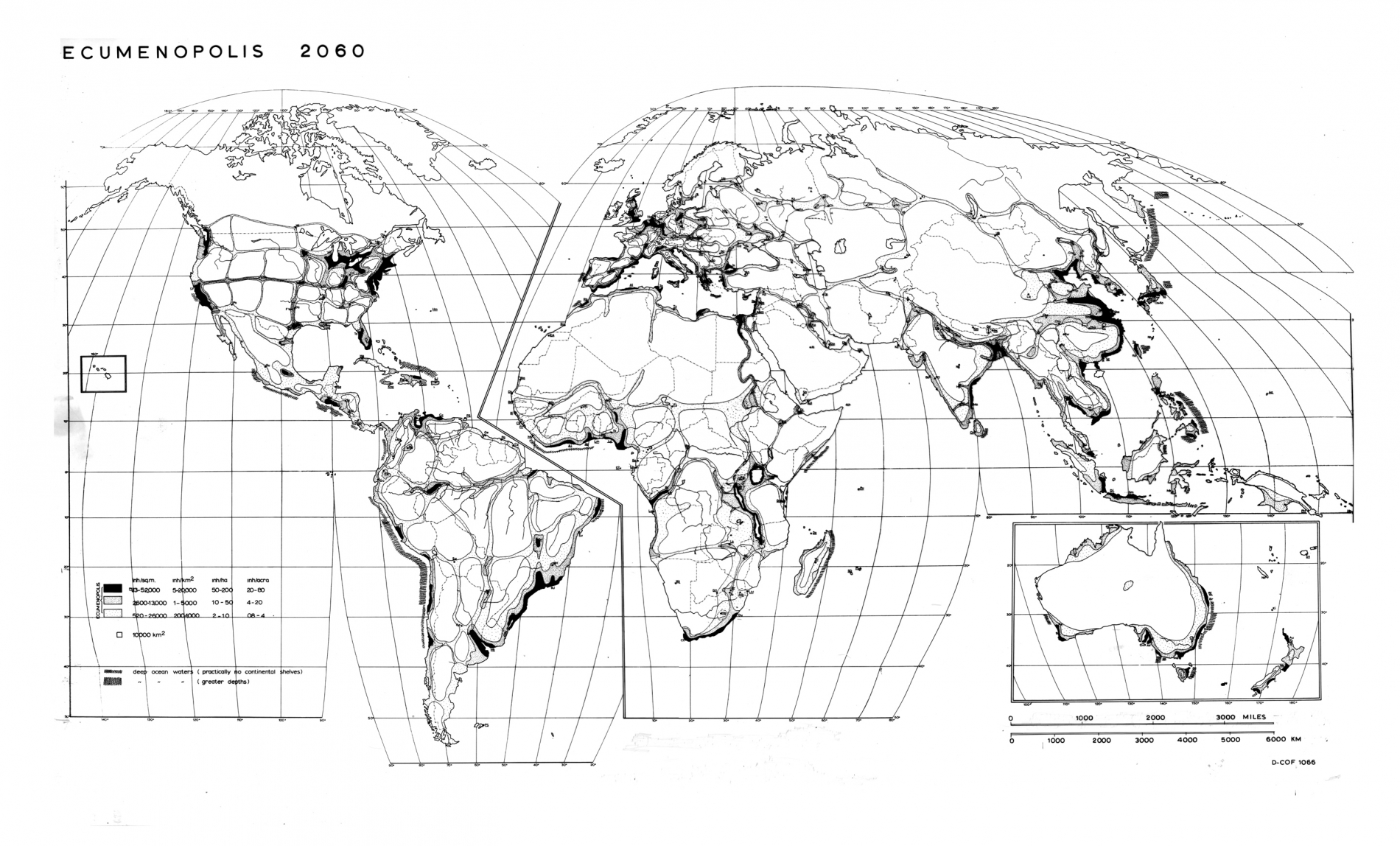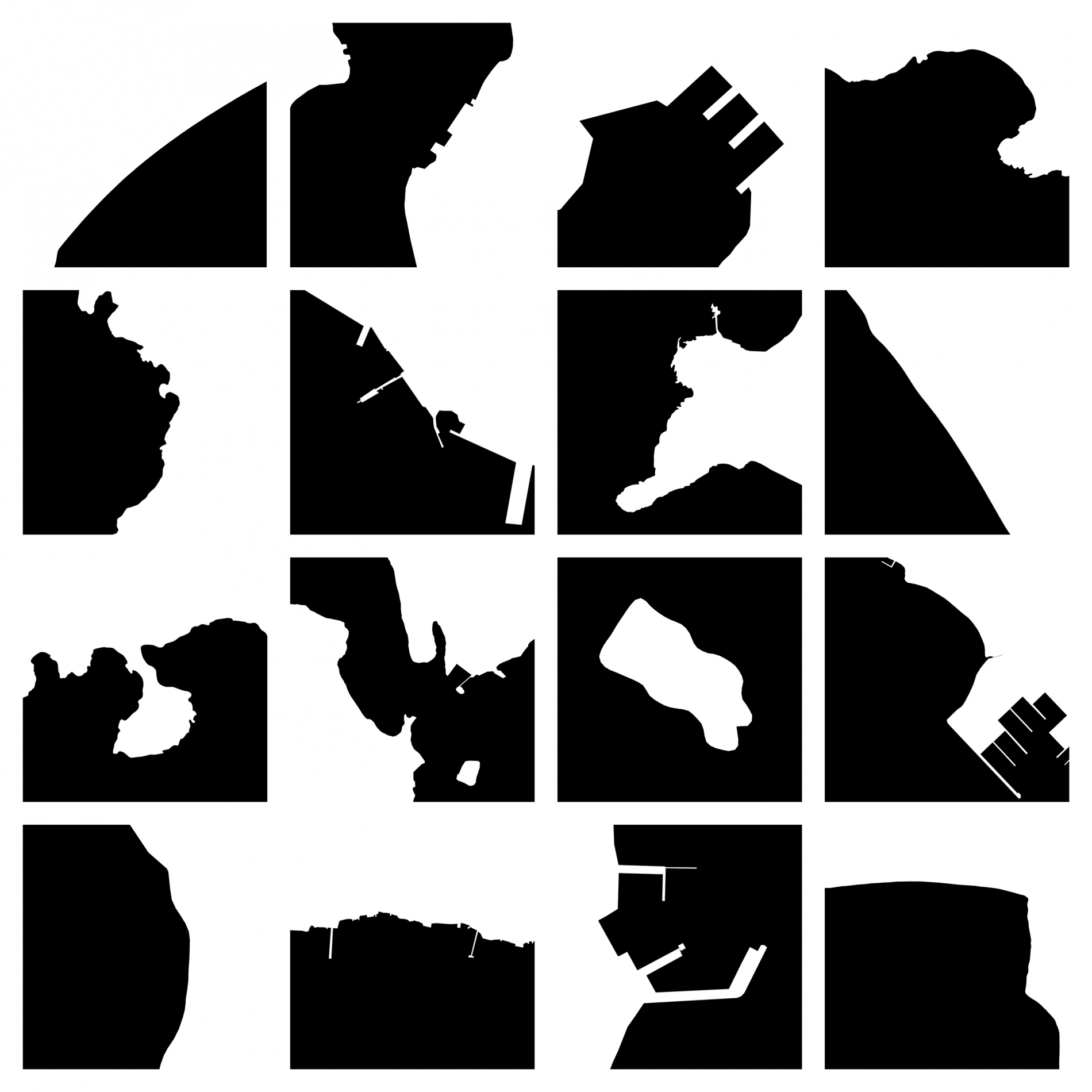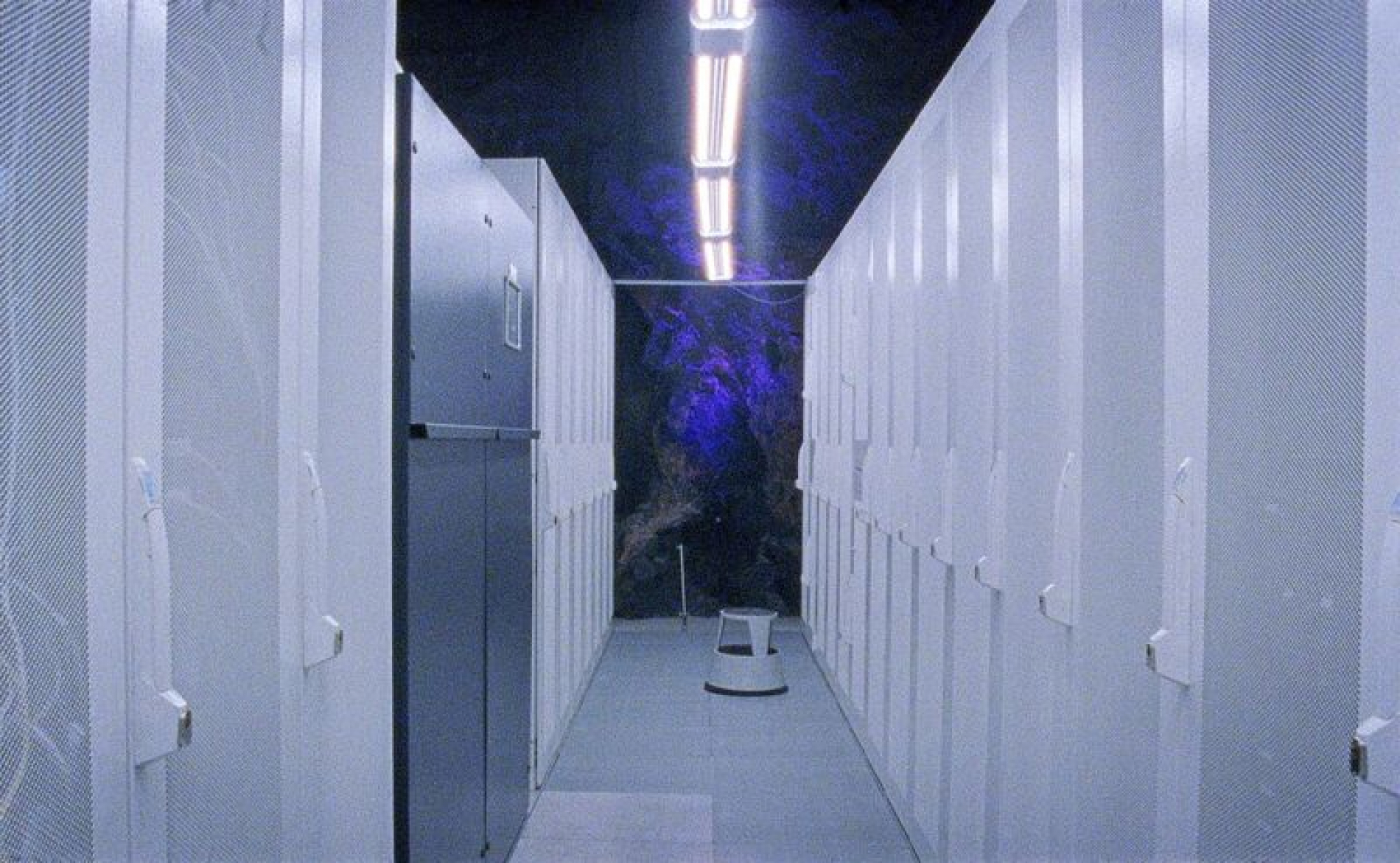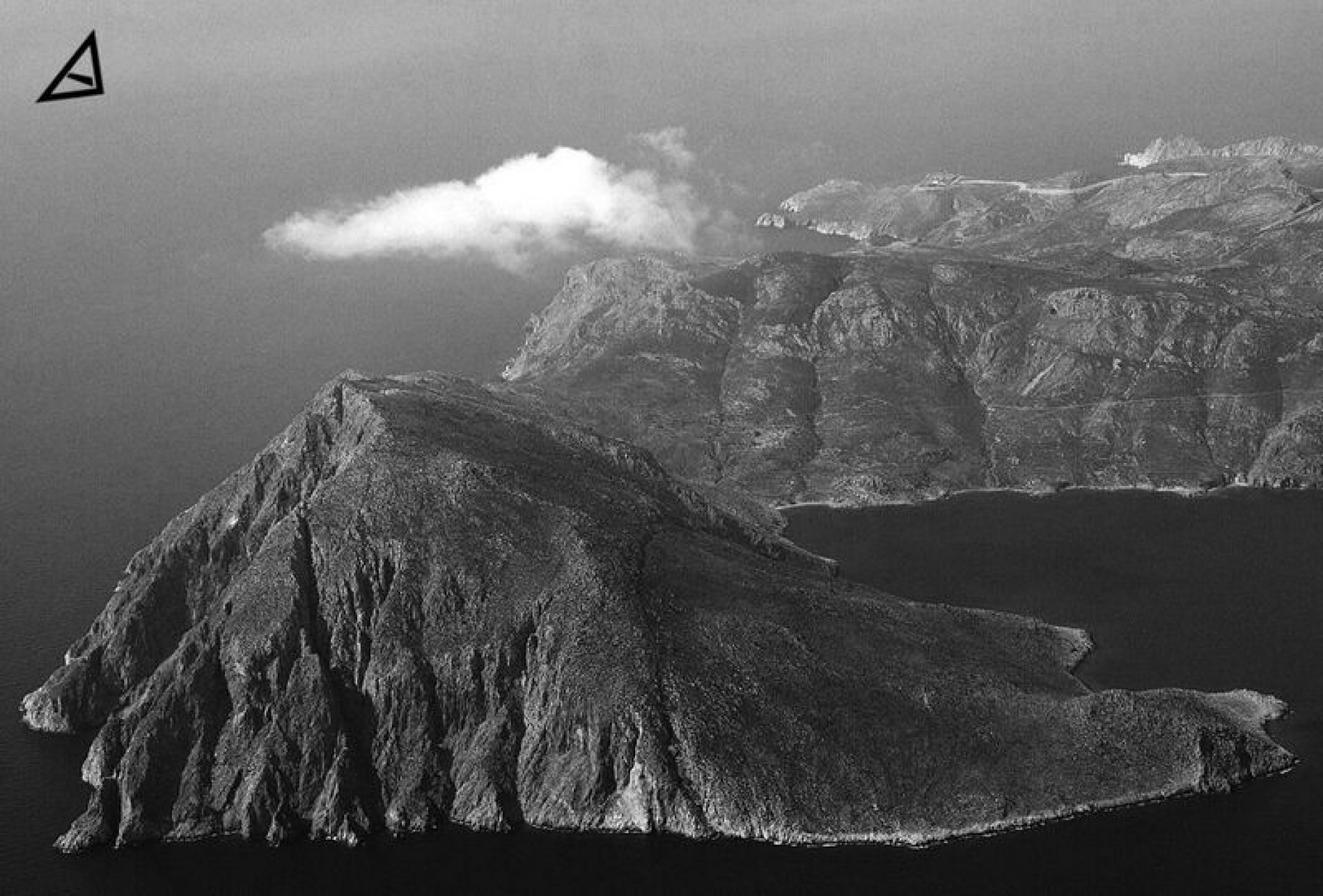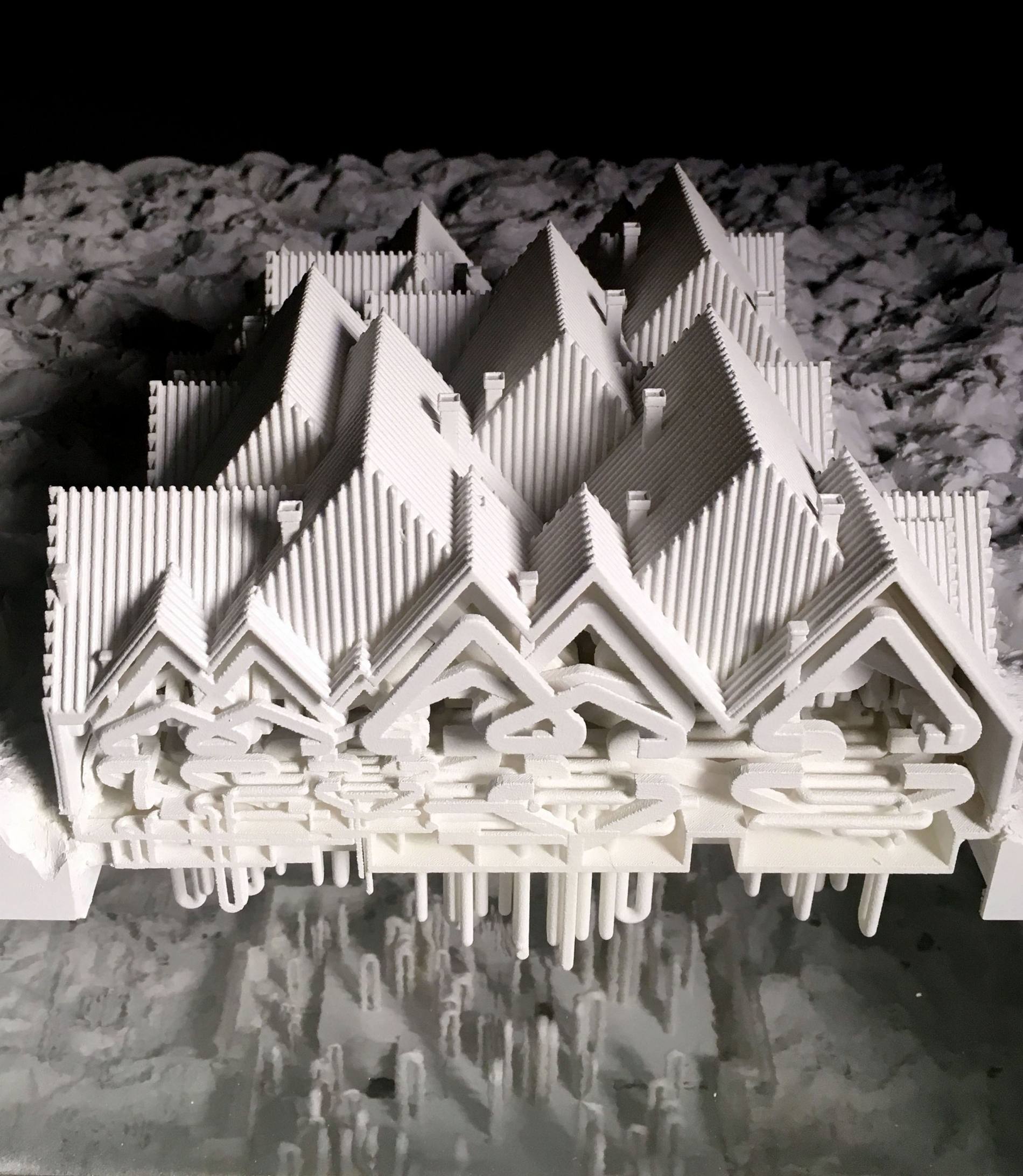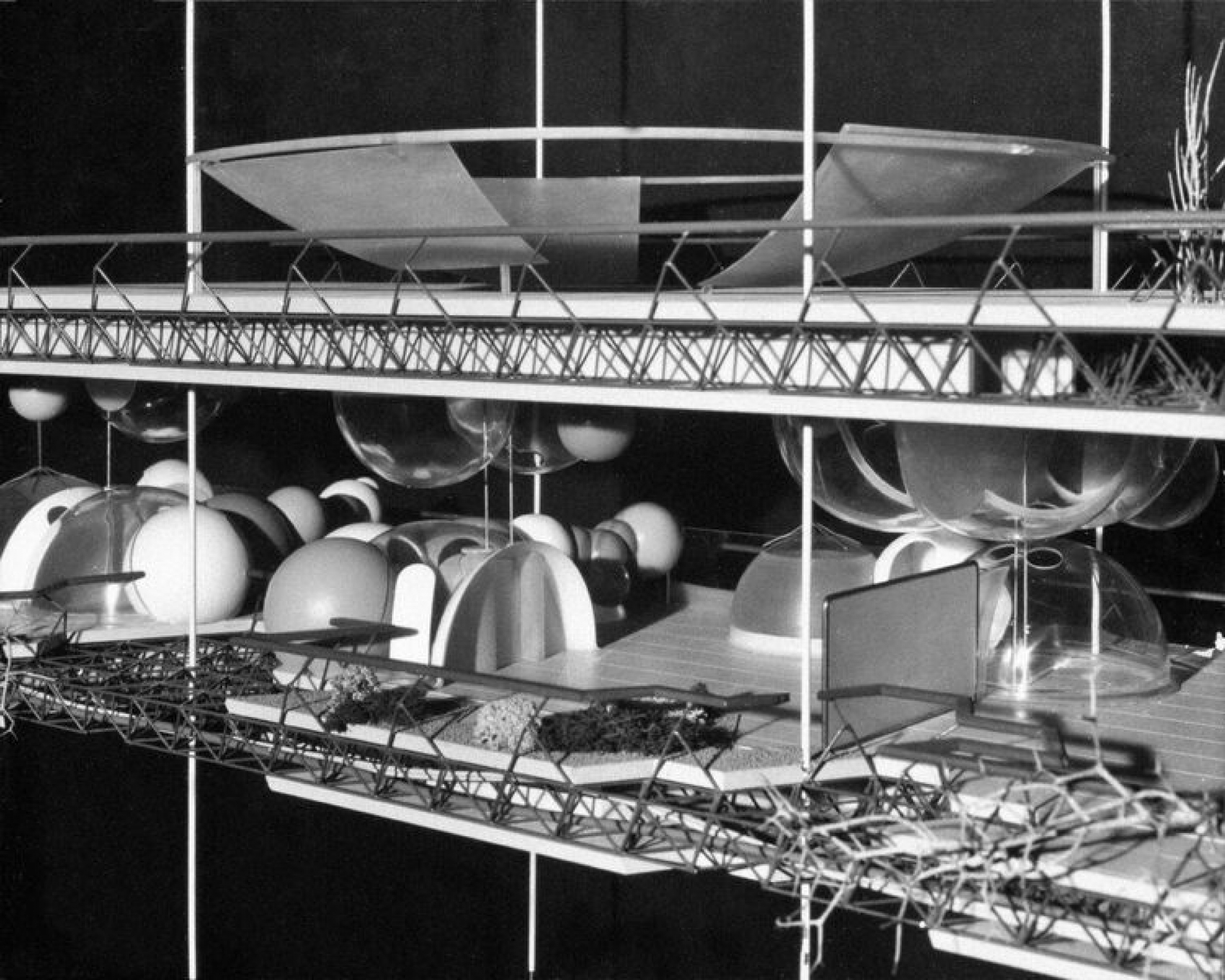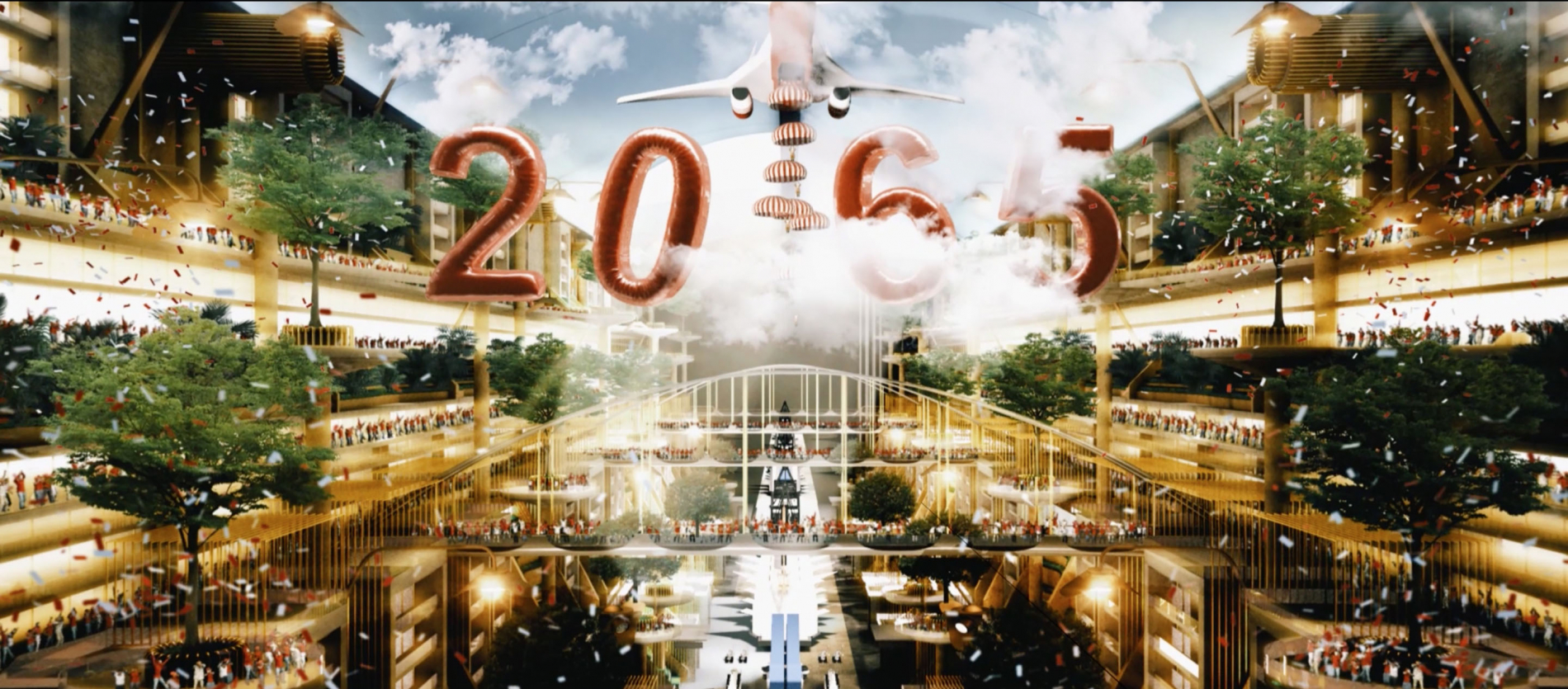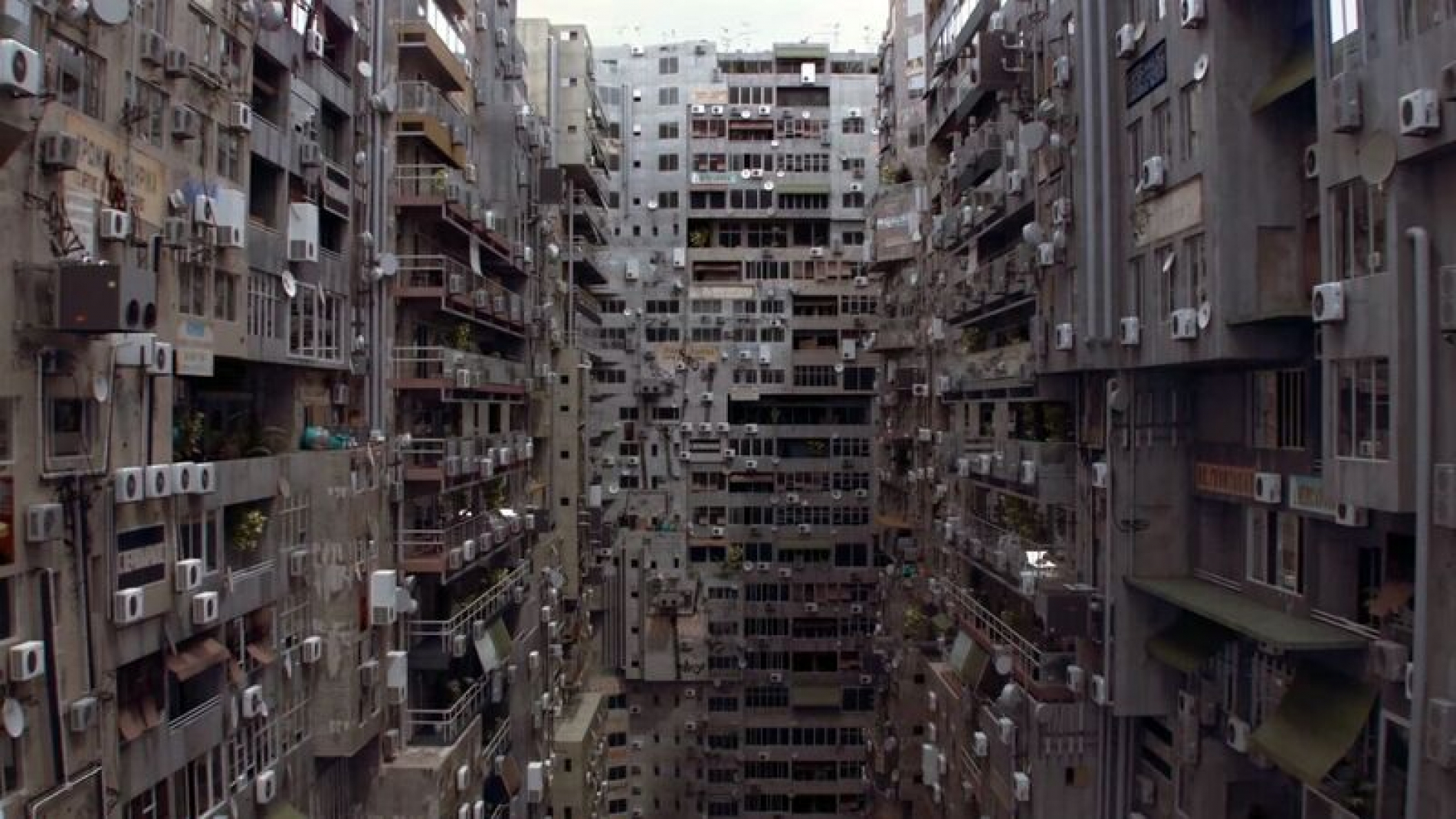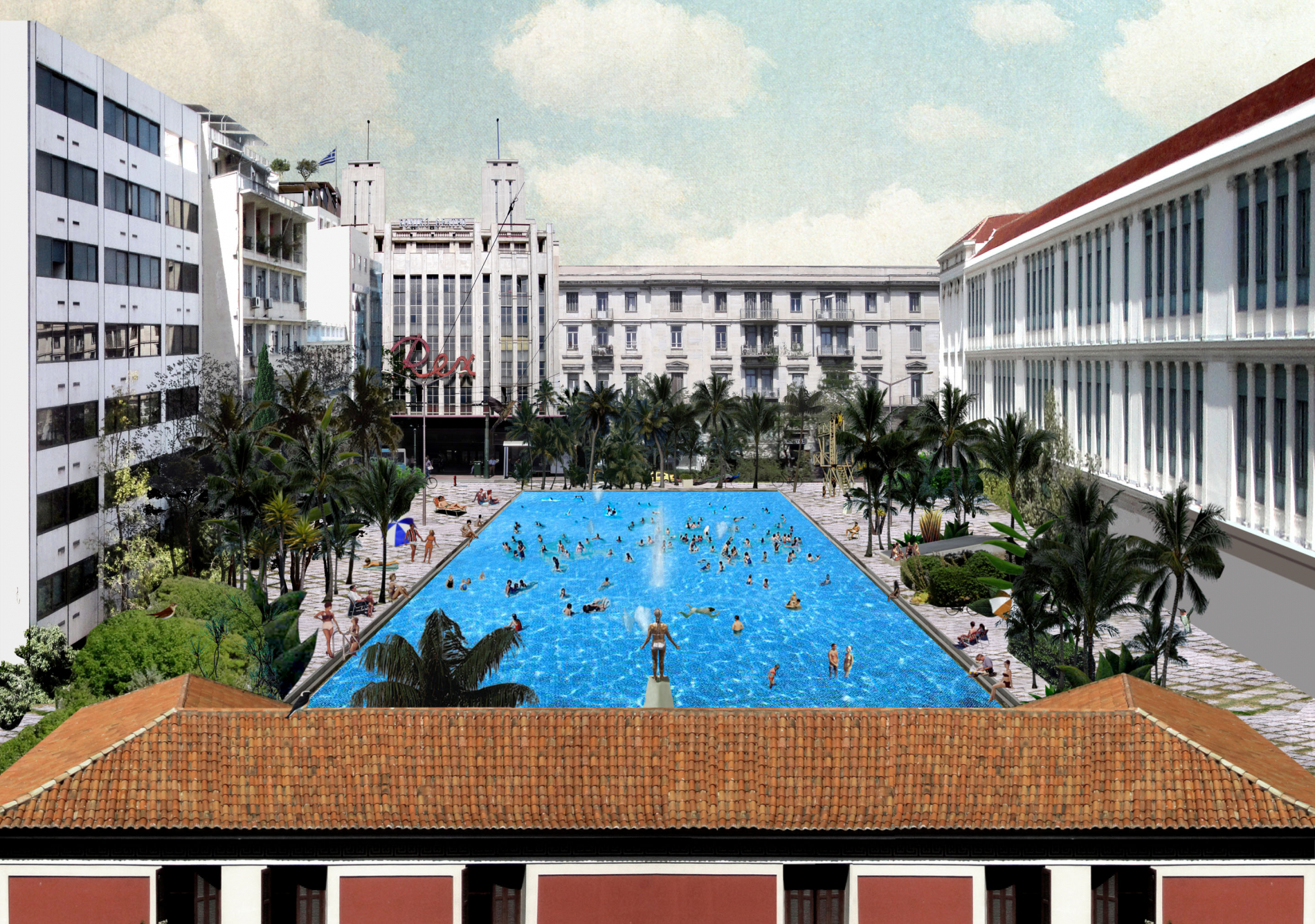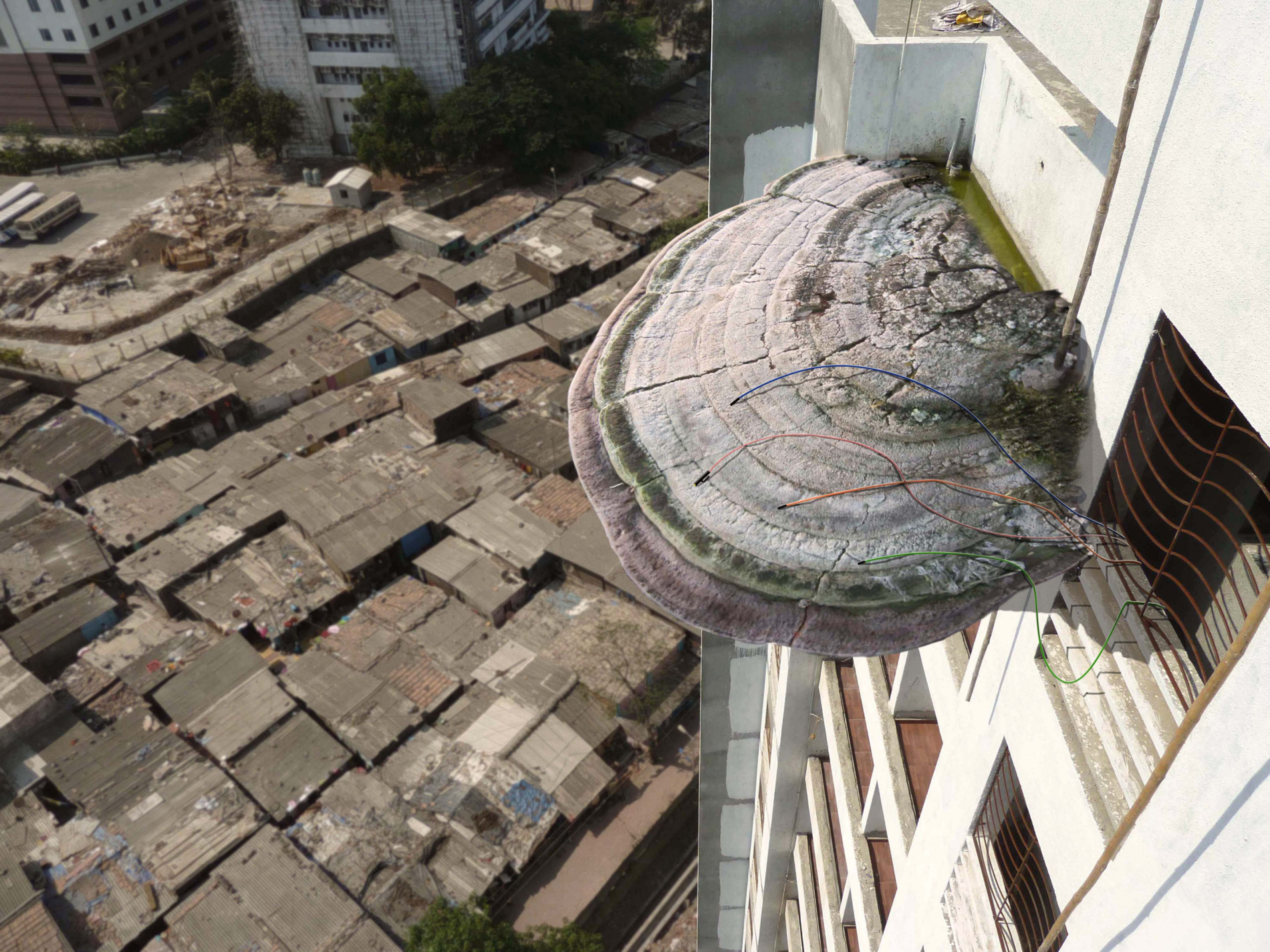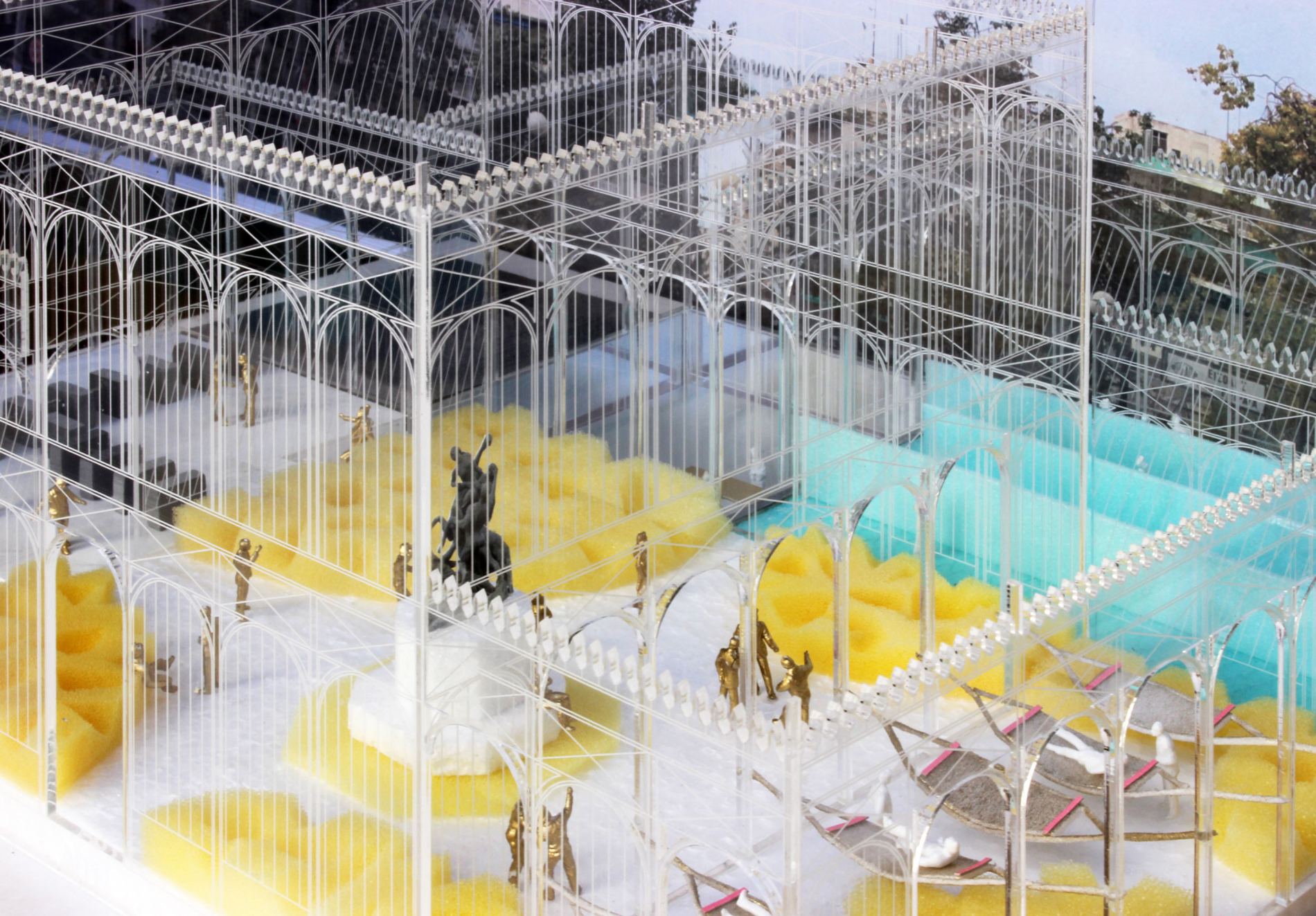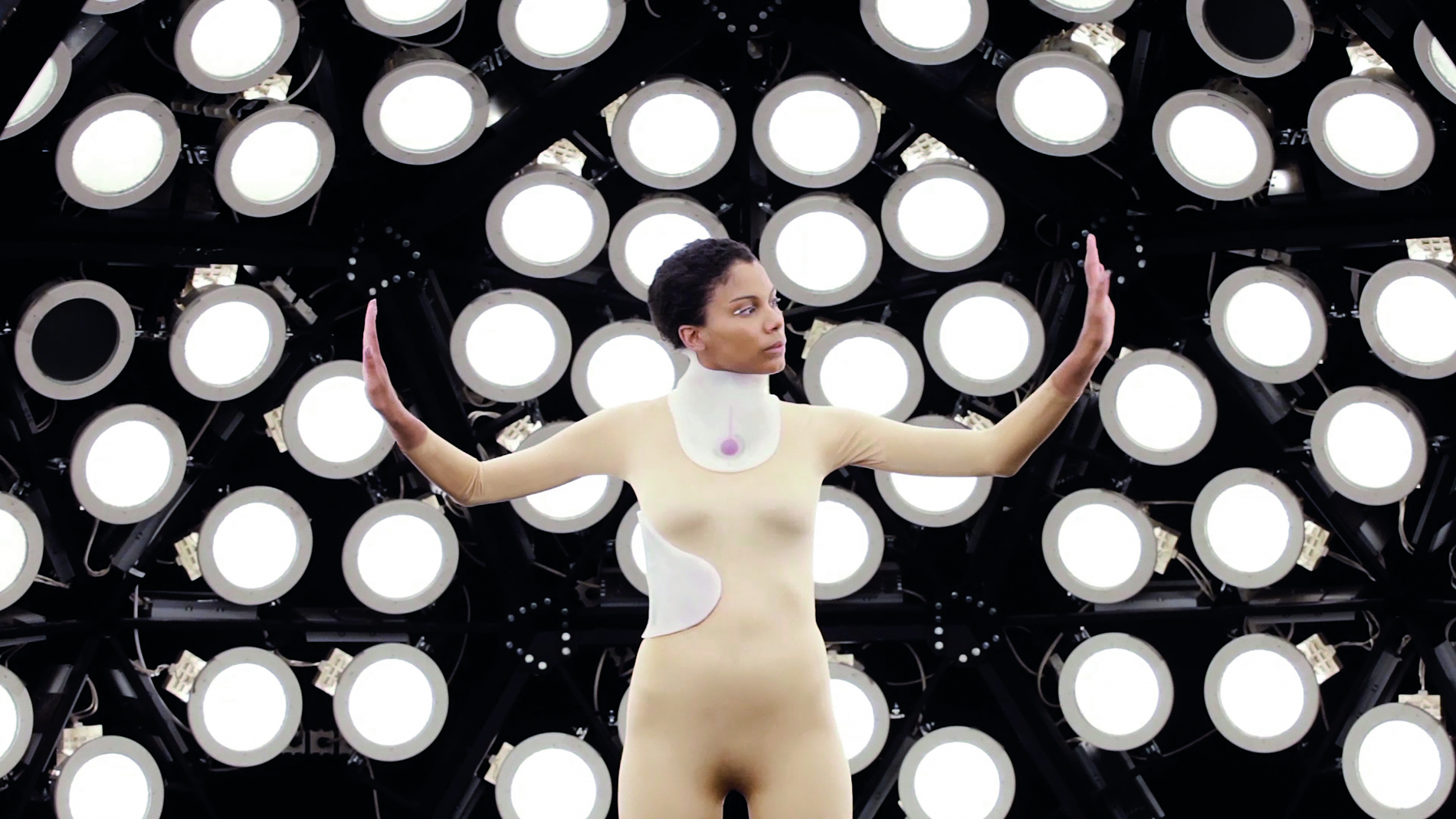
Networks & Infrastructures (17)
The networks’ role has always been decisive for future-oriented scenarios. In the 60s, the city of tomorrow was imagined as a continuously evolving network which, thanks to the up-and-coming systems of communication, information, and transportation, would significantly improve the everyday life. New immaterial architectures would serve the inhabitants with respect to the environment. Nowadays, the electronic networks are at the same time nowhere to be seen and omnipresent. How do our expectations change in an era of ‘clouds’, ‘applications’, and ‘platforms’? How did the past ‘futures’ came to life?
Several works of the exhibition comment on the changes brought by the current condition of constant connectivity, and tackle the sovereignty of today’s networks. They address the changes that the networks brought to work and daily life, but also highlight issues of access and ownership of one’s data. They expose the infrastructures of today’s immaterial networks, underlining their physicality as well as the interdependence of economy, ecology, and technology. They make hypotheses about new network topologies with infrastructures placed in unexpected topographies, and speculations about their management and control by smaller groups of people.
The theory of Ecumenopolis was developed by Constantinos Doxiadis' Athens Center of Ekistics as part of a research project for the “City of the Future” that was funded by the Ford Foundation.
According to Doxiadis, the great increase of urban population and the dynamic growth of cities will lead to their interconnection in a continuous network, into one universal city which we may call the ecumenic city, or Ecumenopolis. This is an inevitable reality that is already under construction and is likely to start acquiring shape at the beginning of the 22nd century. The big question that arises for Doxiadis is not about the dimensions, the structure, and the form of Ecumenopolis, but about its function, the type of life that will be created within it, and the quality of life that will offer to the people.
Doxiadis anticipates that the cities of the future will be extra-human, beyond human's capacity to control them. The world may be led to inhuman conditions as the problems and weaknesses of the 20th century's cities are multiplied. At the same time, he believes that Ecumenopolis may be “the real city of human” as for the first time in history, people will have one city rather than many cities belonging to different national, racial, religious, or local groups. Ecumenopolis will form a continuous, differentiated, but also unified texture consisting of many cells, the human communities. According to Doxiadis, this evolution corresponds to the dream of a cosmopolis, as the ideal state in which all people will be equal and united into one world.
The exhibition includes drawings, diagrams and photographs from the research project for the "City of the Future" where the theory of Ecumenopolis was developed, from lectures and publications by C.A. Doxiadis on the theory of Ekistics, and from the Delos Symposia that Doxiadis organized from 1963 to 1975. All material belongs to the Constantinos A. Doxiadis Archives.
© Constantinos and Emma Doxiadis Foundation
White Mountain is a 16mm docu-fiction film set primarily in the Pionen data center, which is located 30 meters under the granite rocks of Vita Bergen Park in Stockholm. The site used to by a former Cold War-era civil defense bunker and was redesigned in 2008 by architect Albert France-Lanord as a data center to house servers for clients – among which were WikiLeaks and the Pirate Bay. Starting by surveying the rough topography of the surrounding Södermalm landscape, the film gradually pushes beneath the surface and illuminates the ordinarily concealed network infrastructure. As the camera idles on the florescent-lit server stacks, issues of privacy, surveillance and digital sovereignty inevitably emanate. The hydrogen bomb proof subterranean hub has been, interestingly, constructed with direct references to science fiction films such as Silent Running, and the classic Ken Adam’s set design. Playing on the sci-fi aesthetic and with a poetic narration written by Jussi Parikka, White Mountain uncovers the varying forms of temporality captured in data space and geology. Gathering vibrational and electromagnetic sound from the rock above as well as from deep inside the server room itself, the work reveals and processes the reverberations of the hidden environment.
The Mediterranean Sea, in the sidelined European South, has been the stage of major tensions and urgencies due to its geographical particularity and cultural diversity: climate change, population movements, financial crisis, military and political conflicts, tourist exploitation. Part of the Mediterranean Sea, the Aegean archipelago connects but also divides two continents being therefore of crucial importance for many centuries in this area. Having opposed numerous gentrification attempts and investment plans during the last decades, the archipelago is found to accommodate in the future a decentralized network of small, fully sustainable, climate-controlled data centers, constructed on the islands or floating on the water, which enables people to safely and privately store and share their digital information and memory without relying on any kind of corporate cloud. This network of data centers managed by the islanders brings into form a kind of local traditional platform cooperativism. The islanders’ community consists of people who abandoned the urban centers of Europe, former refugees and indigenous islanders. In the face of the harsh and erratic regional conditions, the Aegean Datahaven connects the islands with each other creating new topologies and questioning at the same time the established forms of sovereignty, identity, geography and power. An extended archive of the data centers can be found in the Aegean Datahaven collection. The data centers are depicted on a series of drawings by an unknown traveler.
In the fall of 2016, nine students at the Yale University School of Architecture documented the future infrastructure of Iceland over a 20-year period from 2036 to 2056. This was a speculative archival project 20 years in the past of 40 years from now. The infrastructure was rethought in light of contemporary developments in ecology, technology, and economics; these three issues effect the cultural relations of the built environment at such an accelerating pace that is difficult for a discipline such as architecture to grapple with. The question that the studio dealt with is not the fantasy that architecture can solve these problems, but that architecture is responsible for imagining the aesthetics that the interrelations of these three would provoke in the near future. The participants explored how these accelerated changes redistribute sensible information, and therefore involve politics. The projects presented range in scale and issues addressed. Three general categories were developed, although each project crossed over into the others: Energy Extractio, Distribution Systems, and Information Storage. Each project is documented through 9 images, 1 model, a brief text, and a presentation of research documenting the future media.
List of works:
In Plain Sight by Heather Bizon
Iceland Resolution: The View from Nowhere by Mathew Bohne
Tesla Redoux - Iceland Probe System Report by Pauline Caubel
The Glacial Genome: Looking Back at the Mid-Atlantic Mediation Project by Cat Garcia-Menocal
InfoState Infrastructure by Paul J. Lorenz
From BIM to Garage Bands: The Rise of Energy Hacking by Aymar Marino-Maza
The Hive: The Distribution of the Many by Steven McNamara
Data Landscaping: The Highland Dermis by Maggie Tsang
Razor Mining: Refueling the Cloud by Rob Yoo
Constant’s New Babylon (1959-1974) was a proposal for a city of the future where work would be automated and citizens would engage only with creative activities, based on their disposal, interests, and desires. With more time allowed for joyful encounters and emotional ties, a new urban economy would emerge. Fueled with intense creativity, this new economy and society would be able to utterly change everyday life. And it could. But, visions of the future sometimes are realised in the most controversial ways. Metahaven’s City Rising takes New Babylon as a starting point, and tells the story anew, from a contemporary perspective. It underlines how in times of crisis, a point has been reached that all and nothing is work. All and nothing, therefore, becomes driven by and from love, which is at once honest, barren, and capitalised. In City Rising, different forms and aspects of affective labour are tackled, while we are being invited to think about our bond with this condition, and its promises and compromises.
Electronic Urbanism is a research project in progress for more than 20 years. The first research stage starts during Zenetos' studies in Paris and concludes with the first presentation of the project at the Modern Housing Organization's exhibition in Athens in 1962. The final project for the "City and the house of the future" is presented at the 1st Building Exhibition at Zappeion in 1971. In this project, Zenetos has adapted his design for an all-purpose furniture that was distinguished in the Interdesign 2000 competition (1967).
Zenetos' project for the city of the future is the outcome of systematic research on the development of applications in electronics. Studying articles in scientific journals of the time, Zenetos defines accurately the forthcoming applications of 'tele-management', 'tele-work' and 'tele-services'. Taking into consideration the accelerating changes of living elements in the cities of the future, he proposed flexible systems for both building and infrastructures. He believed that the structure of the city and the house of tomorrow would have to be ephemeral and, as much as possible, immaterial. For this reason, he designed a system of light three-dimensional supporting cable-structures, like a spider's web, containing vertical garden-cities and dense networks of improved telecommunications media. The ground, which was left almost free, was an uninterrupted natural space as the city would expand over forests, lakes, rivers, and seas.
This space structure can receive any type of infill elements, but the most important one is that of the moveable tele-processing cell. The cell is equipped with ananthropomorphic all-purpose furniture, which controls the tele-activities, the audiovisual contacts, and the environmental conditions. According to Zenetos, this control switch is going to be the heart of the human of tomorrow. The adjustment of the furniture's various parts is mechanical through keys, but Zenetos already forecasts that in the future this will be controlled directly by the user's brain, with the help of a hyper-sensitive electro-brain waves receiver.
The material that is presented in the exhibition belongs to the Takis Ch. Zenetos archive.
α2525, Athens in S.F. is based on 13 short stories written by 10 Greek sci-fi authors, who were specifically commissioned to provide them imagining the future of Athens. It is a film project that was subsequently created to address the questions, images and ideas presented in the utopian or dystopian scenarios of the authors. In the form of an omnibus documentary, which makes use of interviews, videos and drawings, the film evokes the writers' visions and hypotheses regarding the city's future in different time periods. The project touches upon several issues such as: climate change; possible epidemics; the application of augmented reality in public space; the fusion of cities through virtual reality; the uncontrollable dissemination of fake news; religious fanaticism; a future society based on collectivity; a new autocratic plan of global development; technologies that are beyond man's control or trigger global geopolitical shifts. The film is accompanied by the published stories on which it is based.
Cinematic Essays of Urban Futures brings together nine short films that take as their subject matter the future of architectural form and the city, what architectural designer and theorist Penelope Haralambidou has called architectural essay films. Originally coined by the German artist and filmmaker Hans Richter, the term 'essay film' describes an intimate, allusive and idiosyncratic cinematic genre at the margins between fiction and documentary. Although under-theorised, the essay film has a long history as a form that thinks and thought that forms, as French film essayist Jean-Luc Godard asserts. Combining digital filmmaking with architectural proposition, the cinematic musings on show bridge theory with practice and design with commentary. By introducing empathy and the dimension of time the films can unlock the storytelling, political and philosophical subconscious of the global city of tomorrow and grasp alternative near-future scenarios.
The films are produced by students in March Unit 24 at the Bartlett School of Architecture, UCL. It is a research laboratory making the most out of recent advancements in digital technology that have brought the disciplines of film and architecture closer than ever before.
Selected by Penelope Haralambidou, the films are organised in three sub-categories:
Tomorrow’s cities: Finbar Fallon, Subterranean Singapore, 2016; Kairo Baden-Powell, Fictional Constructs, 2014; Azizul Hoque, Whalemart City, 2016.
Tomorrow’s buildings: Brook TJ Lin, An Anatomical Embassy, 2016; Angeliki Vasileiou, Weaving the Ineffable 2015; Emir Tigrel, Vestigial Landscapes, 2015.
Tomorrow’s landscapes: Nico Czyz, The Long Now Foundation, 2016; Stefanos Levidis, The Embassy of the Displaced, 2016; Ed Mascarenhas, Barbecana, 2014.
In Tomorrow’s Storeys we drift from room to room, eavesdropping in on the overheard conversations of the occupants of a near future Athenian apartment block. Beginning two months prior to the opening of the Tomorrows exhibition architect Liam Young organised a public think tank consisting of a group of science fiction authors, visual artists, directors, photographers and architects, aiming to produce a series of critical fictions about the future of Athens. Through discussions, illustrations and speculations, the working group authored a series of short stories set within the walls of a single imaginary apartment block, collectively constructing narratives of the future life of Athenian citizens. Evolved from the traditional form of the Polykatoikia, the building they designed is a continuous urban mass where each Athenian is not given a minimum basic income but rather a minimum basic floor area, a percentage of the volume of a building but not a fixed location. The block is a portrayal of a new form of urban organisation where a building is reformatted like a Facebook page and a diverse group of occupants are collapsed together in radical juxtapositions as they roam across the floors, following functions that are shifting by the hour. This is just one temporary moment in a block of endless configurations, a window into a speculative building, the city that surrounds it and the lives it contains.
Considering the future of our cities, a real challenge is to reinvent the way that we are using them today. Especially in cultures with limited means, how could we improve and even transform the cities we have found ourselves living in, in banal, low tech, affordable and immediately realizable ways? Today, cities are often filled with unnoticed, left-over spaces between buildings, while what is typically called public space is no more than unimaginative, hard surface with nature as decoration.
High quality public space could be a critical tool to create compact, efficient and mixed-use cities where residents are close to nature and where urban life is celebrated. They can become magnets similar to monuments, giving identity and value to their surroundings. Inhabitants will be inspired to use the areas close to their homes more, replacing motorized transport with walking and biking, reducing pollution and gaining free time.
High quality public space can be achieved regardless of its size and type. Although rarely the case, it can be playful, fun and optimistic.
During the Indian Civil War, the Dharavi slums of Mumbai were flooded with refugees looking to escape the conflict. The Mumbai authorities, distracted by defense of the city and facing an already over-populated and poverty stricken slum could do little to maintain a semblance of civilised life in the area. Sometime later a cache of biological samples appeared through the criminal networks of Mumbai, in the vain hope that it might provide new marketable narcotic opportunities. The collective drive and expertise of the refugees managed to turn these genetically-engineered fungal samples into a new type of infrastructure providing heat, light and building material for the refugees. Dharavi rapidly evolved its own micro-economy based around the mushrooms. This documentary tells the story of some of the characters involved from Mumbai and the rest of the world and how Dharavi came to be such a unique place.
In the summer of 2015, refugees from the Middle East found temporary shelter at Victoria Square, on their journey to Western Europe. Since then, Victoria, an urban space of bourgeois past and imperial name, has become a nexus of the refugee crisis, with an extended solidarity network providing shelter and guidance.
Victoria: Way In/Way Out imagines the space of Victoria Square as a paradigm for the future of the Mediterranean city. Two parallel urban entities coexist: the ‘Shelter’ and the ‘Transparent State.’ The first emerges within the concrete frames of former polykatoikies, i.e. apartment blocks, that now function as small, live-in ‘factories,’ where a diverse population of urban dwellers engages in the low-tech production and exchange of knowledge, products and services of a post-capitalist society. As an ever-changing, horizontal city perpetually linked to the present, the ‘Shelter ’ is intersected by the ‘Transparent State’: a formal and invariable network of radically privatized infrastructures and public spaces, with restricted access and limited rights, where constant surveillance guarantees safety and conformity to the past.
Victoria Square itself has been transformed into a new Crystal Palace, or ‘Embassy,’ negotiating between the ‘Shelter’ and the ‘Transparent State.’ Mobility and the transitory nature of human occupation are everywhere on display, mediated by control points, waiting rooms and prepared experiences, whereby individuals may or may not be granted further access.
Sarotis, a Greek word for scanner, is a series of soft robotic prosthesis combined for the first time with 3D vision systems to create a whole new way of sensing space through the body. It is predicted that by 2020, 5.4 billion mobile devices will feature 3D sensors enabling any user to scan and store their environments. If 3D vision technologies turn out to be as successful as their 2D predecessors, 70% of the world's population is expected to be capable of scanning, storing and analysing their environments.
Sarotis, developed at the Interactive Architecture Lab, Bartlett UCL, aims to explore how 3D vision technologies will change the way humans see and interact with the world. It looks into possible intimate wearable technology futures and examines how advanced vision systems and other sensory technologies will possibly be connected directly to the body through their soft interfaces.As part of the study an experimental prosthesis and a film were produced. The prosthesis was designed to study how one's awareness of space can be amplified using live 3D scanning technologies that control the inflation and deflation of soft robotic wearables. The speculative film invites the viewer to consider how fluidic hydrogel interfaces may dissolve the distinction between our own physiology and that of the softening machines that will extend our bodies.
Other possible applications of the project include assisting the blind or visually impaired with navigation, or in providing haptic feedback for virtual reality environments.
Project developed and released by Interactive Architecture Lab in the Bartlett led by Ruairi Glynn.
We largely conflate technology with speed, imagining near futures that are dystopian and accelerated, efficient and lifeless. Technology is exclusively considered fast, dynamic, frenetic. The future is closer than it may appear--maybe just an invention away. It moves at the speed of a signal, transforms instantly, and displaces generations in ever-shorter cycles. But technology can move as slow as it does fast. What if we considered how it might resistprogress, counter efficiency and derail optimization?
Man fears time; time fears the pyramids, warns a 12th century Arab proverb. We understand the pyramid as the most enduring form of resistance: weathering the storms of humanity and cultural change. Pyramids allure us with myth, with scale, and with the impossibility of their construction. They seduce us with their platonic clarity, elemental materiality and ambiguous use. They withstand. They are a bit ridiculous.
For Tomorrows, the New Affiliates have produced a pyramid generator: a black box process that samples from the digital universe to produce new kinds of pyramids every four minutes. Whatever is plugged into the generator will read the pyramids: bring a printer, and you’ll soon find a stack of postcards; plug in your phone, and they’ll pop up on screen; attach a speaker and you’ll hear them described. Yet no matter your engagement, no matter the state of technological progress, and no matter time, the generator will continue forever; producing an infinite set of relations, networks and data all reduced to a platonic that only knows to resist.
Ashley Madison Angels at Work in Athens is part of a series of works researching Ashley Madison, a Canadian online dating service marketed worldwide to married people seeking casual sex. In July and August 2015, an anonymous group called The Impact Team stole and released all of Ashley Madison's internal data–including the entire website code and functionality, customer data and the CEO's emails. The data breach revealed that with a disproportionate number of male subscribers and virtually no human women on the site Ashley Madison had created an army of 75,000 female chatbots to draw the 32 million male users into (costly) conversations. This triggered !Mediengruppe Bitnik to use Ashley Madison as a case study to raise questions around the current relationship between human and machine, Internet intimacy and the use of virtual platforms to disrupt the physical.
For Tomorrows, !Mediengruppe Bitnik uses the localized data from the Ashley Madison hack to give atemporary physical embodiment to 7 of the 165 fembots that were active in Athens at the time of the data breach. Each fembot has a name, an age and a location and uses sentences from a list of pick-up lines to contact other users. The 165 fembots of Athens provided entertainment to around 22.910 registered users in Athens.
What if political governance were replaced by one speaking kitten AI?
The year is 2039. After years of political turmoil catalysed by R-Crisis EMEA, a refugee crisis triggered by war and the detrimental effects of climate change, the incompetence of the political elites to generate and retain trust in the populations becomes ever more obvious. Politicians across Europe and EMEA countries fail to serve the sentient human.
One pioneering neuro-engineer develops an artificially intelligent and–for the first time–feeling virtual being. Kitty AIis an artificial intelligence with the affective capacities of a cat who can love up to 3 million people. The AI not only carries the tasks of a governor; it also takes care of its citizens at a personal level. It takes care of garbage disposal, makes sure your children get to school safely and drink clean water. She/he/it manages the citie's household budget, and maintains diplomatic relations with both physical and virtual leaders of the world.
This speculative future scenario is inspired by the Black Mirror episode "TheWaldo Moment,” where a cartoon character becomes a presidential candidate, an idea that seems less absurd considering the political developments of 2016/2017. German author Leif Randt’s novel Planet Magnon enfolds a narrative in which computers run an entire galaxy, a concept that is supported by the emerging field of Global Systems Science.


